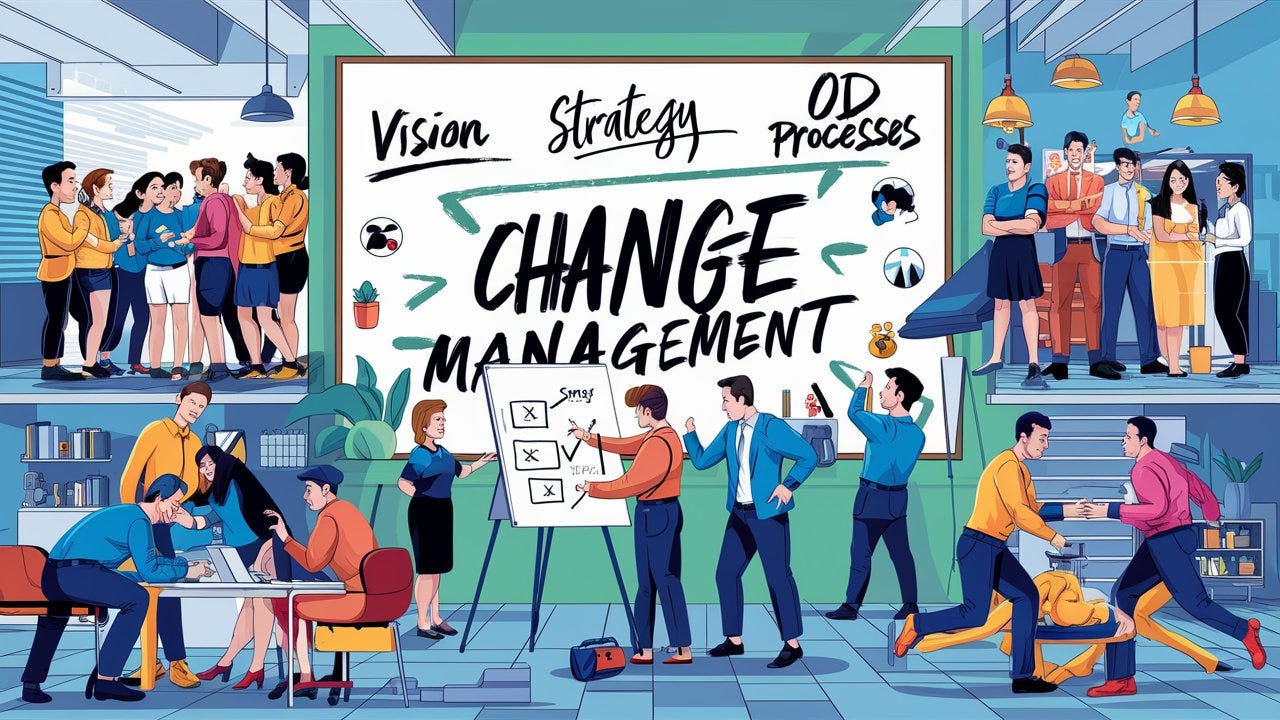Exponential Change
With the rate of change accelerating, especially with advancements like AI, conventional change management approaches, many rooted in WWII strategies, are becoming obsolete. Organizations that once thrived in stable environments are now at risk, needing to adapt as quickly as their ecosystems demand. Many OD practitioners overlook this reality, clinging to myths such as "leadership's support ensures change management success." But why?
The Leadership-Focused Myopia
Conventional thinking still considers leadership the main driving force behind successful transformations. Leadership sets the vision, defines the strategy, and inspires the workforce to embrace change. This top-down approach is appealing because it seemingly simplifies the change process: if the leadership is united, the rest of the organization will naturally follow. However, this perspective can lead to significant oversights.
For instance, leaders at the top may be detached from day-to-day operations and the challenges employees face. This disconnect can result in strategies that look good on paper but are impractical or irrelevant in practice. Additionally, effective change requires robust, two-way communication channels. Overemphasis on leadership can lead to unidirectional information flow, where feedback is not adequately acted upon.
A Vicious Cycle of Inaction
This myth creates an invisible cycle of inaction, felt by OD practitioners as an impenetrable wall resisting change. The cycle starts when an OD practitioner seeks leadership support for a change. Expectations about each other's roles build up independently. With a thumbs-up, leadership signals that the OD team can proceed. Will they?
Simultaneously, the OD team may expect continued support (e.g., trust, authority, guardianship, appreciation) from leadership. This dependency can grow, creating unnecessary reliance and potentially blowing out of proportion. Can we blame these two actors for the action paralysis?
While in this inaction zone, the real change users—often the doers, facilitators, influencers, champions, opinion makers, mavens, connectors, advocates, enablers, employees, customers, and forthcoming AI agents—grapple with their realities and contributions to the organization. These change users wield significant influence over their peers, often more than those with official titles. Their joint efforts can filter, reshape, or resist the change despite leadership and the OD team’s efforts. These "unseen" actors can hijack the organization in a cycle of inaction, undermining the intended change while the ecosystem continues to evolve.
Engaging the Change Users
To avoid the pitfalls of a leadership-centric change management strategy, OD practitioners must adopt a more balanced approach that involves change users at all levels. The idea of organizations having only a leadership-managers-employees structure is obsolete in dynamic ecosystems. Here are some strategies to achieve this balance:
1. Map the Change Users Early: Use social network analysis (SNA) to identify and track the formal and informal roles and communication channels of change users. Engage and involve them early and often. Solicit their input during the planning phase and keep them informed throughout. This inclusion fosters a sense of ownership, collaboration, and reduces resistance.
2. Leverage Title-less Leaders: Identify and engage informal influencers within the organization. These individuals can act as change champions, spreading positive attitudes and behaviors among their peers more effectively than those with official titles.
3. Tailor Communication Strategies: Develop communication plans that ensure a two-way flow of information. Regularly seek feedback from employees and demonstrate that their input is valued and acted upon. Feedback is crucial for pivoting actions towards ongoing change processes.
4. Provide Adequate Support and Training: Equip change users with the necessary skills and knowledge to navigate changes. Offer comprehensive and highly customized training and support resources to facilitate a smooth transition.
5. Pivot, Pivot, Pivot: Continuously monitor the progress of change initiatives and be willing to adjust based on verified feedback and emerging challenges. Flexibility and responsiveness are key to successful change management.
OD professor Thijs Homan shares his research finding that 'lived experience' is more relevant than many organization theories. In his TED presentation, he discusses how people in organizations, like schools, can transform smoothly, emphasizing the importance of the inner side of organizational change.
NOTES
1. ODLab24 will happen on July 4 to 5 in the Sugarland Hotel, Bacolod City. Catch the excitement with us!
Ed Canela's Courses
1. Leadership in Managing Change and Innovation via zoom, July 12, 2024 IN SAIDI’s Leadership Development Program (by Invites Only).
2. AI in CSR for Education and Sustainability Studies (With Dr. Jocelyn Pick) for Polytechnic University of the Philippines, July 7, 2024 (by Invites Only).
3. 5th Data Analytics for MSMEs. 3 Saturdays (starting July 6, 2024) In-Person hands-on at the University of the Philippines Institute for Small Scale Industries (UPISSI) REGISTER NOW. REACH US AT: University of the Philippines Institute for Small-Scale Industries Room 401, Fourth Floor, E. Virata Hall, E. Jacinto Street, UP Campus, Diliman Quezon City, Philippines 1101 Trunk Line: 8981-8500 loc. 4054 or connect to our Facebook site.
4. AI, DFIs, Climate Change & You for the Association of Development Finance Institutions for Asia and the Pacific (ADFIAP), July 23 to 26,2022 Makati (by Invites Only).
5.SAIDI Webinars: (a)AI for HROD Professionals August 1, 2, and 5 from 9:30 am~4:00 pm for HR/OD Professionals, Trainers, Consultants, and Senior Managers; (b) 2nd Al for Academics, Sept 5, 6 and 9 from 9:30 am~4:00 pm for Academics, Principals, Teachers, Education Advocates, and CHED/DepED specialists and staff. Contact SAIDI by e-mailing Cynthia Cruz at cecruz@saidi.edu.ph or calling her (8-5545373).




